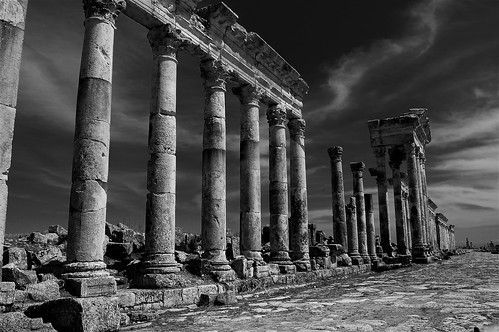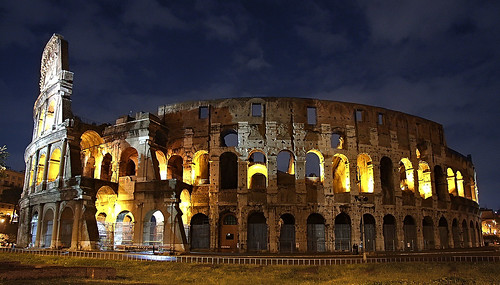Two iron-cast faux-Egyptian Sphinxes flank the either side of Cleopatra’s Needle in the City of Westminster, London. Although the original intention of the Sphinxes would have been to appear to be guarding the needle, an installation error means they are both facing the needle instead. The right hand Sphinx is visibly damaged after an aerial bombing campaign during the First World War saw a bomb land near Cleopatra’s Needle. To commemorate the event, the shrapnel holes remain unrepaired on the Sphinx to this day. This beautiful photograph by Manju shows one of the Sphinxes were it rests alongside the River…
-
-
In a joint partnership with the Open University, the BBC broadcast the first of a seven-part series which is looking at the History of Britain through art and artefacts over the past 2,000 years in a TV series called “Seven Ages of Britain“. Shot in high definition, the programme is written and presented by the respected veteran broadcaster David Dimbleby who recounts the ancient-era story of the nation in the first episode. Heritage Key’s new series – Ancient World in London – which starts next week will build on the insights with a look at the age of Roman and…
-
Black and White photography is an artform unto itself – it’s so much more than just clicking “Greyscale” in Photoshop, which will oftentimes just give a bland result. Several adjustments and the right lighting is required to make a black and white image work, and in Robinho’s image of Roman ruins in Apamea, Syria we see a fantastic, dramatic shot. The city of Apamea was adjacent to the Orontes River as served as a treasure city of the Seleucid. It was annexed and formed part of the Roman Empire from 64BC, and it is from the Roman era that many…
-
After a recent visit to Rome, Jon dropped off some images to me from the Museo della Civilt Romana in EUR (Esposizione Universale Roma) of one of the most beautifully crafted architectural models I’ve ever seen of Ancient Rome. As a bit of an architecture buff, and having spent 5 years studying it, I’ve developed a small addiction to UHU Glue and can’t really look at balsa wood anymore without my hand subconsciouslly reaching out for a craft knife. Model making was the fun part of studies when I would attempt to use a variety of materials including foamboard, tin…
-
Possibly one of the creepier Heritage Key Daily Flickr Finds that I’ve picked out from our Flickr pool, but this photograph of the remains of this Egyptian Mummy housed in the British Museum captivates me. The angle it’s taken at, looking at its profile as it stares upwards gives the impression that there’s still life in this millennia old corpse. The open jaw gives the mummy an eerie feeling, with the clarity of each tooth bared. The composition of the photograph is also intruiging. It’s an image where you’re interested in what’s not shown just as much as what is.…
-
Karnak is home to several temples and ruined chapels, and is the largest ancient site in the world. Within the site is the Great Hypostyle Hall, Karnak, which is a popular tourism hotspot. Located in the Precinct of Amun-Re, the hall covers an area of 5 square kilometres, and is composed of 134 columns divided within 16 rows. The composition and angle of this fantastic photograph by ktildsley inside the Great Hypostyle Hall is captivating, giving a sense of how high up the roof would have been. The tall columns appear almost intimidating, closing in the shot tightly and the…
-
Photography is often a case of having to wait for that perfect shot, as Vit Hassan discovered when visiting Meroe. The golden sands of the desert against the ancient Nubian pyramids gave the perfect backdrop, and after taking his photograph, Vit Hassan took the one Heritage Key features ten minutes later as the shadows set into the landscape, and the scenery became more defined. The Sahara desert covers the length of Egypt, down to the site of the city ofMeroe, near the modern day border with Sudan aside the River Nile. Meroe intrigues many archaeologists for the sense of mystery…
-
The home to some of the greatest shows on Earth, Rome’s Colosseum had a capacity of 50,000 making it the largest built by the Romans. Where gladiators would have battled and public shows would be held, this amazing monument is captured beautifully by Dmitriy Moiseyev in this photograph. Taken at dusk, the interior lights can be seen glowing from within the structure, emanating a glow about this ancient relic. Rome’s Colosseum differs from many of the Greek amphitheatres preceding it, as it is a freestanding structure as opposed to being built into a hillside. With such a high capacity, the…
-
The British Museum is home to one of the world’s finest collections of artefacts and treasures. With such beauties as the Elgin Marbles (Which the Greeks want back, by the way) and the Rosetta Stone (Which Dr Hawass wants to see given back to Egypt) and is currently housing the newly discovered Staffordshire Hoard. Amanda Slater’s lovely shot inside the Great Court inside the British Museum shows nicely the way the light coming in from the modern glass roof shines down inside the historic interior. The roof of the Queen Elizabeth II Great Court, designed by prominent British architect Sir…
-
Black and White photography is an artform in itself – it’s so much more than simply clicking the “greyscale” option in Photoshop. It’s about adjusting the contrast, lighting and many other factors to achieve that perfect composition! Just ask Brian H who achieved a powerful and stunning effect in his photograph of Dover Castle. The castle, which contains a Roman lighthouse (Pharos) within its grounds, is one of Britains most iconic defensive strongholds, and recently underwent a 2 million renovation of its Great Tower. The photograph, although taken at some distance, brings the details of the stonework together with the…









